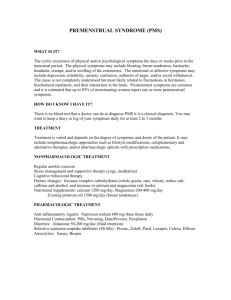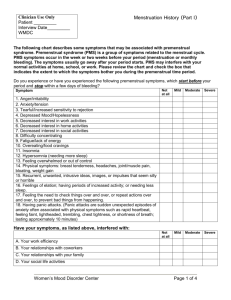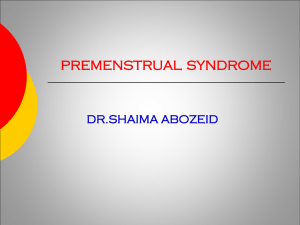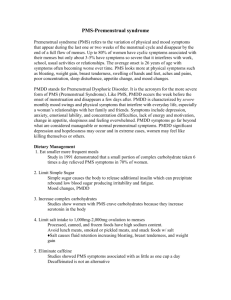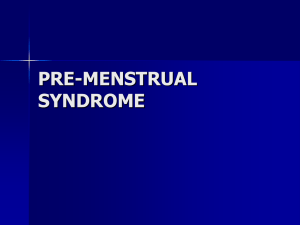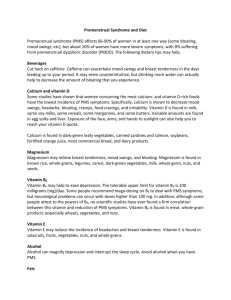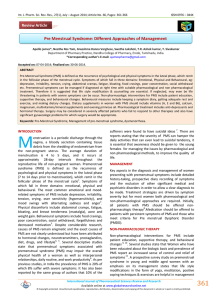Bayer Schering Pharma Symposium
advertisement
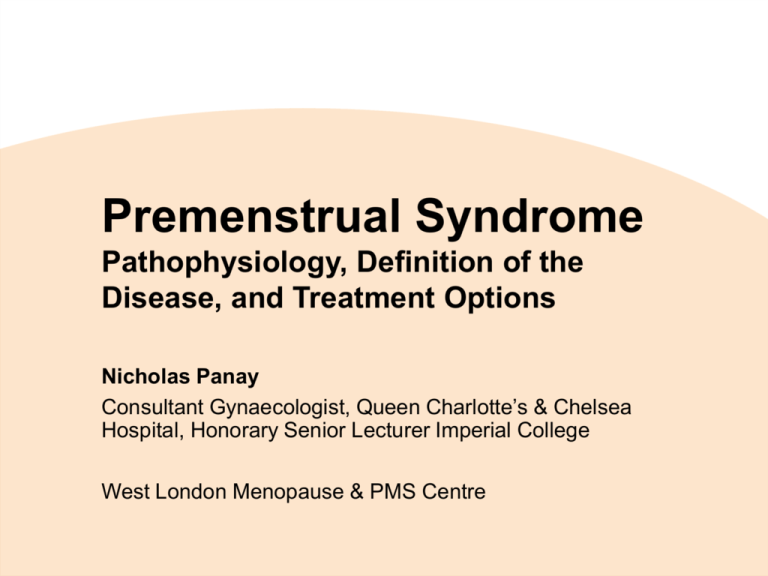
Premenstrual Syndrome Pathophysiology, Definition of the Disease, and Treatment Options Nicholas Panay Consultant Gynaecologist, Queen Charlotte’s & Chelsea Hospital, Honorary Senior Lecturer Imperial College West London Menopause & PMS Centre Premenstrual Syndrome History Hippocrates -‘….shivering, lassitude and heaviness of the head denotes the onset of menstruation….’ Henry Maudsley (1873) - First to make connection between PMS & cyclical ovarian activity Greene & Dalton (1953) - Introduced the term “premenstrual syndrome” Studd (1988) - Ovarian cycle syndrome - Menstruation not an essential feature of PMS Fashionable 19th. Century Disorders in Women ► Neurasthenia ► Insanity ► Menstrual madness ► Nymphomania ► Masturbation ► Moral insanity ► Hysteria all often due to reading serious books or playing music Maudsley “…The monthly activity of the ovaries which marks the advent of puberty in women has a notable effect upon the mind and body; wherefore it may become an important cause of mental and physical derangement …” Premenstrual Syndrome Modern Definition Distressing physical, psychological and behavioural symptoms, not caused by organic disease, which regularly recur during the same phase of the menstrual (ovarian) cycle and which significantly regress or disappear during the remainder of the cycle Magos & Studd (1984) PMDD Definition (DSM IV - Diagnostic and Statistical Manual of Mental Diseases) (4th edn. American Psychiatric Association, 1994) Five or more of the following present premenstrually (one must be a core* symptom): Markedly depressed mood * Marked anxiety/tension* Marked affective lability Marked anger/irritability* Decreased interest in usual activities* Difficulty concentrating Lethargy/fatigue Appetite change/food cravings Sleep disturbance Feeling overwhelmed Physical symptoms (e.g. breast tenderness, bloating) Symptoms in most menstrual cycles during the last year (retrospective confirmation) and in at least two cycles as prospective confirmation Occur the last week before menses and remit within a few days of onset of menses Marked interference with work, social activities, relationship Premenstrual Syndrome Symptoms – Prevalence SWS 2007 Sadler Inskip Panay (Submitted) ► >25 000 Women Surveyed ► 30% stated that PMS severely affected their quality of life (cf PMDD 3-8%) ► Positive correlation of PMS with obesity / less exercise / less qualifications ► Less PMS with increasing hormonal contraceptive use Premenstrual Syndrome Symptoms Over 160 PMS related symptoms Moos (1968) ► Physical e.g. breast tenderness, headache, bloating ► Psychological e.g. mood swings, irritability, depression ► Behavioural e.g. lowered cognitive performance, accidents, suicide attempts Premenstrual Syndrome Diagnosis ► History Primary PMS: Complete resolution of symptoms at onset of menstruation Dalton (1977) Secondary PMS: Improvement of symptoms following menstruation, even if only for a few days Premenstrual Syndrome Diagnosis ► Validated Prospective symptom diaries • Confirm diagnosis more accurately than retrospective recall ► Moos Menstrual Distress Questionnaire (MDQ/PDQ) »Moos 1968, Magos/Studd 1987 (Oestradiol trials) ► Daily Record of Severity of Problems (DRSP) »Endicott & Harrison NY State Psych Inst 1990, Arch Women’s Mental Health 2006 (Yaz trials) ► Premenstrual Symptoms Screening Tool (PSST) »Steiner et al Arch Womens Ment Health 2003 (SSRI trials) Premenstrual Syndrome Proposed Pathophysiology in PMS ► Biological Glucocorticoids Androgens Prolactin Fluid retention Vitamin deficiency •A •B6 Antidiuretic hormone Reactive hypoglycaemia Prostaglandins •excess •deficiency •prolactin hypersensitivity Endogenous opiate peptides •mid luteal increase •premenstrual withdrawal Endogenous hormone allergy Menstrual toxin Magnesium deficiency Neurotransmitters •cholinergic •catecholamines •serotonin Melatonin ►Psychological ►Social & evolutionary ►Genetic Premenstrual Syndrome Aetiology ► No convincing evidence for any of the postulated biological or psychological mechanisms ► May be multiple aetiologies (E2/serotonin, Progesterone-allopregnanolone/GABA) ► Ovarian function appears to play an essential role in the genesis of symptoms Studd (1979) Premenstrual Syndrome Aetiology ► Serotonin • • • • • Lower platelet concentrations Lower luteal phase levels Enhanced sensitivity to progesterone Levels elevated by oestradiol SSRIs effective for PMDD Ashby Biol Psych 1988, Rapkin Obstet Gynecol 1987, 1997 Premenstrual Syndrome Aetiology ► GABA • Major inhibitory system in CNS • Low levels of GABA in mood disorders • Low levels in women with PMDD during late luteal phase Brambilla Mol Psych 2003; Halbreich Am J Psych 1996 Premenstrual Syndrome Aetiology ► Allopregnanolone • Metabolite of progesterone – potent neurotransmitter • Positive modulator of GABA receptor • Bimodal Action on mood symptoms High levels anxiolytic Low levels lead to emotional lability • Low levels in follicular & luteal phases PMS/PMDD • Impaired response to GnRH / ACTH stimulation • Impaired steroidogenesis by Corpus Luteum Genazzani J Clin Endocrinol Metab 1998, EJE 2000 Gyne Endocrinol 2004, Bicikova Horm Metab Res 1998, Miczek Horm Behav 2003 The triad of Oestrogen Responsive Depressive Disorders Postnatal depression Premenstrual depression Climacteric depression Premenstrual Syndrome Proposed Treatments for PMS ► Pharmacological ► Psychological & Social Support ► Miscellaneous Diuretics Bromocriptine Magnesium Desensitization GnRH analogues Psychoactive drugs -SSRI inhibitors -tranquillizers -lithium Prostaglandin mediators -PG synthetase inhibitors, g linolenic acid Vitamins -B6, A, E Sex hormones -progesterone -progestogens -combined pill -danazol -LHRH analogues -oestradiol implants and patches -androgens Physical Activity Diet Hypnosis Meditation Yoga Acupuncture Bilateral oophorectomy Radiation menopause Management of Mild / Moderate PMS Healthier lifestyle Nutrition Stress management Counselling/support Mild medications Evening primrose Diuretics Vitamins & minerals B6, A & D Magnesium Zinc Moderate / Severe PMS Moderate/severe PMS Psychological/physical ??Progesterone Psychological/physical COC/ Oestradiol /Other Resistant PMS GnRHa + add-back Resistant PMS TAH BSO HRT Psychological SSRI's / SNRIs Premenstrual Syndrome Treatment - Ovulation Suppression Agents COCP ► Graham & Sherwin (1992) J Psych Res ► Little benefit with COCP despite ovulation suppression. progestogenic PMS-like side effect & pill free week ► Rapkin (2003) Psychoneuroendocrinol anti-androgenic, antimineralocorticoid progestogen, drosperinone –Yasmin COCP showing promise Premenstrual Syndrome Treatment - Yasmin® Freeman J Wom Health Gen B Med & 2001 & Eur J Con Rep Hlth Care 2002 Pilot RCTs Yasmin v placebo Sig benefit v placebo – NEED MORE DATA Use bicycling / tricycling or continuous regimen unless BTB Premenstrual Syndrome Treatment – Yaz® (only available in US) ► Yonkers K. (Yale) et al Obstet Gynecol 2005 ► EE 20mcg / Drospirenone 3mg, 24 active/4 inactive ► RCT 2 month run in 3 treatment cycles in 450 women PMDD ► Response (50% reduction in daily symptoms): 48% active v 36% placebo p = 0.015 Premenstrual Syndrome Treatment - Progestogens ► AVOID! “Model for premenstrual syndrome” Magos & Studd BJOG (1986) Wyatt et al BMJ Meta analysis (2001) ► POP Replaces cyclical with continuous progestogenic SE’s Especially androgenic POP’s Premenstrual Syndrome Treatment - Oestradiol Patches ► ► 40 patients with PMS confirmed by PDQ and MDQ Randomised double blind placebo controlled with 3 month cross-over Active treatment: 200mcg patches + Oral NET D19-26 Placebo treatment: Placebo patches + Oral NET D19-26 Gp1: Active treatment -> Placebo Gp2: Placebo -> Active treatment Watson & Studd (1989) Lancet Mood Swings Symptom cluster rating 2 Placebo-Active Active-Placebo 1.8 1.2 0.8 0.4 0 0 1 2 3 Time (months) 4 5 6 Watson & Studd (1989) Lancet Oestrogen Therapy ►100µg patches tried subsequently As effective Fewer symptoms of breast discomfort and bloating Less anxiety about high dose oestrogen therapy Smith RNJ, Studd JWW et al; BJOG 1995 Is 100 μg – or 200 μg- Estradiol Patch Anovulatory? Important information for young women who need treatment for PMS and contraception. But totally unproven - so don’t risk it!! Premenstrual Syndrome Treatment - SSRI’s ► Steiner M. et al 1995 NEJM Fluoxetine in treatment of premenstrual dysphoria 405 women in 2 month placebo washout phase 313 women randomised to fluoxetine 20mg, 60mg or placebo Both doses significantly superior to placebo in reducing tension & irritability by VAS Premenstrual Syndrome Treatment - SSRI’s ► Luteal phase fluoxetine as effective with fewer side-effects Dimmock et al Lancet 2000 Efficacy of selective serotonin-reuptake inhibitors in premenstrual syndrome: a systematic review. ► Take home tip: Mildest SSRI therapy Citalopram 10 – 20mg luteal phase (D15 – D28) Premenstrual Syndrome Treatment - GnRH Analogues ► Very effective for PMS - also diagnostic ► Unsuitable for long term use alone ► HRT add back to prevent menopausal symptoms and bone loss Leather, Studd Gyne Endocrinol 1999 Meta Analysis of RCTs (GnRHa vs placebo) Muse et al.18 (IM[D-Trp-ProNEt-GnRH 50 µg daily) Freeman et al.19 (depot leuprolide 3.75 mg monthly) Brown et al.20 (depot leuprolide 3.75 mg monthly) Leather et al.22 (depot goserelin 3.6 mg monthly) Overall anovulatory GnRHa doses Non-ovulatory dosing regimens Sundstrom et al.21 (100 µg nasal buserelin daily)* Overall GnRH doses (anovulatory and non- anovulatory favors placebo favors GnHRa -10 -8 -6 -2 -2 Standard mean differences 0 2 Wyatt et al 2004 Premenstrual Syndrome: Pathophysiology, Definition of the Disease and Treatment Options Summary ► Prevalence of severe PMS/PMDD 10 – 30% ► E2/serotonin and Prog:Allo/GABA most plausible aetiologies in genetically vulnerable women ► Confirmation of severe PMS/PMDD by validated rating scales essential Premenstrual Syndrome: Pathophysiology, Definition of the Disease and Treatment Options Summary ► Training of Health Professionals of paramount importance to aid recognition of condition ► Management ideally should be by multidisciplinary teams ► Moderate/severe PMS usually needs medical intervention - sooner rather than later to avoid unnecessary suffering Premenstrual Syndrome Future Aims ► Confirmation of benefits of new COCPs/ long cycle COCPs ► Licensing of Yaz® for PMS/PMDD in Europe Long Cycle COCPs Transdermal oestradiol GnRHa + add-back for severe PMS Thank you for your attention!
